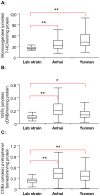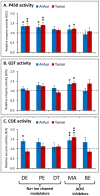Multiple resistances and complex mechanisms of Anopheles sinensis mosquito: a major obstacle to mosquito-borne diseases control and elimination in China
- PMID: 24852174
- PMCID: PMC4031067
- DOI: 10.1371/journal.pntd.0002889
Multiple resistances and complex mechanisms of Anopheles sinensis mosquito: a major obstacle to mosquito-borne diseases control and elimination in China
Abstract
Malaria, dengue fever, and filariasis are three of the most common mosquito-borne diseases worldwide. Malaria and lymphatic filariasis can occur as concomitant human infections while also sharing common mosquito vectors. The overall prevalence and health significance of malaria and filariasis have made them top priorities for global elimination and control programmes. Pyrethroid resistance in anopheline mosquito vectors represents a highly significant problem to malaria control worldwide. Several methods have been proposed to mitigate insecticide resistance, including rotational use of insecticides with different modes of action. Anopheles sinensis, an important malaria and filariasis vector in Southeast Asia, represents an interesting mosquito species for examining the consequences of long-term insecticide rotation use on resistance. We examined insecticide resistance in two An. Sinensis populations from central and southern China against pyrethroids, organochlorines, organophosphates, and carbamates, which are the major classes of insecticides recommended for indoor residual spray. We found that the mosquito populations were highly resistant to the four classes of insecticides. High frequency of kdr mutation was revealed in the central population, whereas no kdr mutation was detected in the southern population. The frequency of G119S mutation in the ace-1 gene was moderate in both populations. The classification and regression trees (CART) statistical analysis found that metabolic detoxification was the most important resistance mechanism, whereas target site insensitivity of L1014 kdr mutation played a less important role. Our results indicate that metabolic detoxification was the dominant mechanism of resistance compared to target site insensitivity, and suggests that long-term rotational use of various insecticides has led An. sinensis to evolve a high insecticide resistance. This study highlights the complex network of mechanisms conferring multiple resistances to chemical insecticides in mosquito vectors and it has important implication for designing and implementing vector resistance management strategies.
Conflict of interest statement
The authors have declared that no competing interests exist.
Figures






Similar articles
-
Relationship between knockdown resistance, metabolic detoxification and organismal resistance to pyrethroids in Anopheles sinensis.PLoS One. 2013;8(2):e55475. doi: 10.1371/journal.pone.0055475. Epub 2013 Feb 6. PLoS One. 2013. PMID: 23405157 Free PMC article.
-
Insecticide resistance of Anopheles sinensis and An. vagus in Hainan Island, a malaria-endemic area of China.Parasit Vectors. 2014 Mar 3;7:92. doi: 10.1186/1756-3305-7-92. Parasit Vectors. 2014. PMID: 24589247 Free PMC article.
-
Landscape genetic structure and evolutionary genetics of insecticide resistance gene mutations in Anopheles sinensis.Parasit Vectors. 2016 Apr 23;9:228. doi: 10.1186/s13071-016-1513-6. Parasit Vectors. 2016. PMID: 27108406 Free PMC article.
-
Mutations in the voltage-gated sodium channel gene of anophelines and their association with resistance to pyrethroids - a review.Parasit Vectors. 2014 Oct 7;7:450. doi: 10.1186/1756-3305-7-450. Parasit Vectors. 2014. PMID: 25292318 Free PMC article. Review.
-
Evolution of insecticide resistance and its mechanisms in Anopheles stephensi in the WHO Eastern Mediterranean Region.Malar J. 2020 Jul 17;19(1):258. doi: 10.1186/s12936-020-03335-0. Malar J. 2020. PMID: 32680514 Free PMC article.
Cited by
-
Distribution and frequency of G119S mutation in ace-1 gene within Anopheles sinensis populations from Guangxi, China.Malar J. 2015 Nov 25;14:470. doi: 10.1186/s12936-015-1000-0. Malar J. 2015. PMID: 26608572 Free PMC article.
-
Emerging Mosquito Resistance to Piperonyl Butoxide-Synergized Pyrethroid Insecticide and Its Mechanism.J Med Entomol. 2022 Mar 16;59(2):638-647. doi: 10.1093/jme/tjab231. J Med Entomol. 2022. PMID: 35050361 Free PMC article.
-
Widespread multiple insecticide resistance in the major dengue vector Aedes albopictus in Hainan Province, China.Pest Manag Sci. 2021 Apr;77(4):1945-1953. doi: 10.1002/ps.6222. Epub 2021 Jan 8. Pest Manag Sci. 2021. PMID: 33301644 Free PMC article.
-
Development of Resistance to Pyrethroid in Culex pipiens pallens Population under Different Insecticide Selection Pressures.PLoS Negl Trop Dis. 2015 Aug 14;9(8):e0003928. doi: 10.1371/journal.pntd.0003928. eCollection 2015. PLoS Negl Trop Dis. 2015. PMID: 26275298 Free PMC article.
-
Correlation between adult pyrethroid resistance and knockdown resistance (kdr) mutations in Aedes albopictus (Diptera: Culicidae) field populations in China.Infect Dis Poverty. 2018 Sep 4;7(1):86. doi: 10.1186/s40249-018-0471-y. Infect Dis Poverty. 2018. PMID: 30176907 Free PMC article.
References
-
- WHO (2012) Global plan for insecticide resistance management in malaria vectors. WHO Press, World Health Organization, Geneva, Switzerland.
-
- WHO (2006) Global Malaria Program: Use of indoor residual spraying for scaling up global malaria control and elimination. WHO position statement. Geneva: World Health Organization.
-
- GFATM (2013) The global fight against malaria. Geneva: Global Fund to Fight AIDS, Tuberculosis and Malaria. http://wwwtheglobalfundorg/en/about/malaria/.
-
- WHO (2013) Test procedures for insecticide resistance monitoring in malaria vector mosquitoes. World Health Organization, Geneva, Switzerland.
-
- Kaneko H (2011) Pyrethroids: mammalian metabolism and toxicity. J Agric Food Chem 59: 2786–2791. - PubMed
Publication types
MeSH terms
Substances
Grants and funding
LinkOut - more resources
Full Text Sources
Other Literature Sources
Miscellaneous

